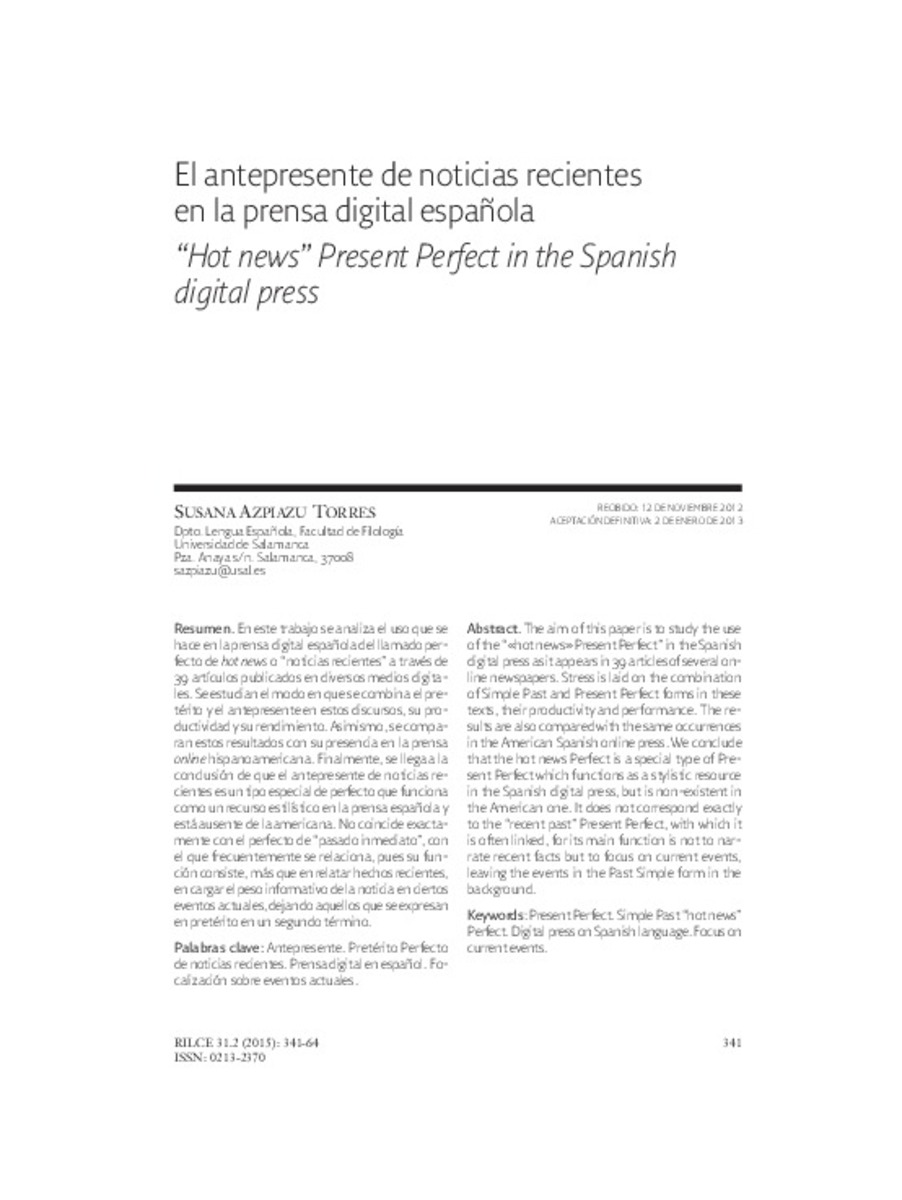Full metadata record
| DC Field | Value | Language |
|---|---|---|
| dc.creator | Torres, S. (Susana) | - |
| dc.date.accessioned | 2016-04-19T08:59:10Z | - |
| dc.date.available | 2016-04-19T08:59:10Z | - |
| dc.date.issued | 2015 | - |
| dc.identifier.citation | Azpiazu-Torres, S., ""El antepresente de noticias recientes en la prensa digital española"", RILCE, Servicio de Publicaciones de la Universidad de Navarra, Vol.31.2, (2015), pp. 341-364 | es_ES |
| dc.identifier.issn | 0213-2370 | - |
| dc.identifier.uri | https://hdl.handle.net/10171/40363 | - |
| dc.description.abstract | En este trabajo se analiza el uso que se hace en la prensa digital española del llamado perfecto de hot news o “noticias recientes” a través de 39 artículos publicados en diversos medios digitales. Se estudian el modo en que se combina el pretérito y el antepresente en estos discursos, su productividad y su rendimiento. Asimismo, se comparan estos resultados con su presencia en la prensa online hispanoamericana. Finalmente, se llega a la conclusión de que el antepresente de noticias recientes es un tipo especial de perfecto que funciona como un recurso estilístico en la prensa española y está ausente de la americana. No coincide exactamente con el perfecto de “pasado inmediato”, con el que frecuentemente se relaciona, pues su función consiste, más que en relatar hechos recientes, en cargar el peso informativo de la noticia en ciertos eventos actuales, dejando aquellos que se expresan en pretérito en un segundo término. | es_ES |
| dc.description.abstract | The aim of this paper is to study the use of the “«hot news» Present Perfect” in the Spanish digital press as it appears in 39 articles of several online newspapers. Stress is laid on the combination of Simple Past and Present Perfect forms in these texts, their productivity and performance. The results are also compared with the same occurrences in the American Spanish online press. We conclude that the hot news Perfect is a special type of Present Perfect which functions as a stylistic resource in the Spanish digital press, but is non-existent in the American one. It does not correspond exactly to the “recent past” Present Perfect, with which it is often linked, for its main function is not to narrate recent facts but to focus on current events, leaving the events in the Past Simple form in the background. | es_ES |
| dc.language.iso | spa | es_ES |
| dc.publisher | Servicio de Publicaciones de la Universidad de Navarra | es_ES |
| dc.rights | info:eu-repo/semantics/openAccess | es_ES |
| dc.subject | Materias Investigacion::Filología y Literatura::Filología hispánica | es_ES |
| dc.subject | Antepresente | es_ES |
| dc.subject | Pretérito Perfecto de noticias recientes | es_ES |
| dc.subject | Prensa digital en español | es_ES |
| dc.subject | Focalización sobre eventos actuales | es_ES |
| dc.subject | Present Perfect | es_ES |
| dc.subject | Simple Past “hot news” Perfect | es_ES |
| dc.subject | Digital press on Spanish language | es_ES |
| dc.subject | Focus on current events | es_ES |
| dc.title | El antepresente de noticias recientes en la prensa digital española | es_ES |
| dc.type | info:eu-repo/semantics/article | es_ES |
| dc.identifier.doi | 10.15581/008.31.1547 | es_ES |
Files in This Item:
Statistics and impact
Items in Dadun are protected by copyright, with all rights reserved, unless otherwise indicated.






